Prasusafe 10mg Tablet 10's
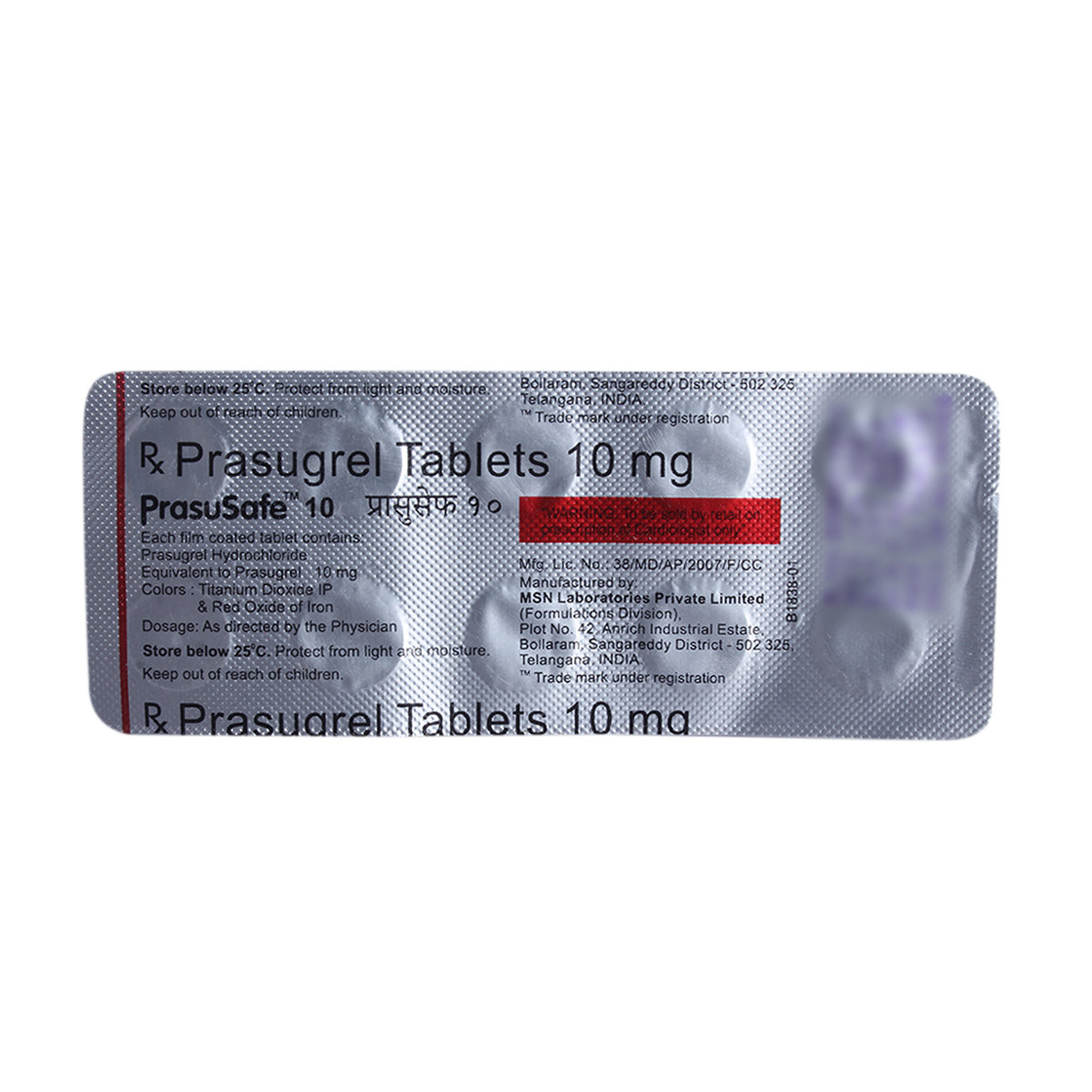
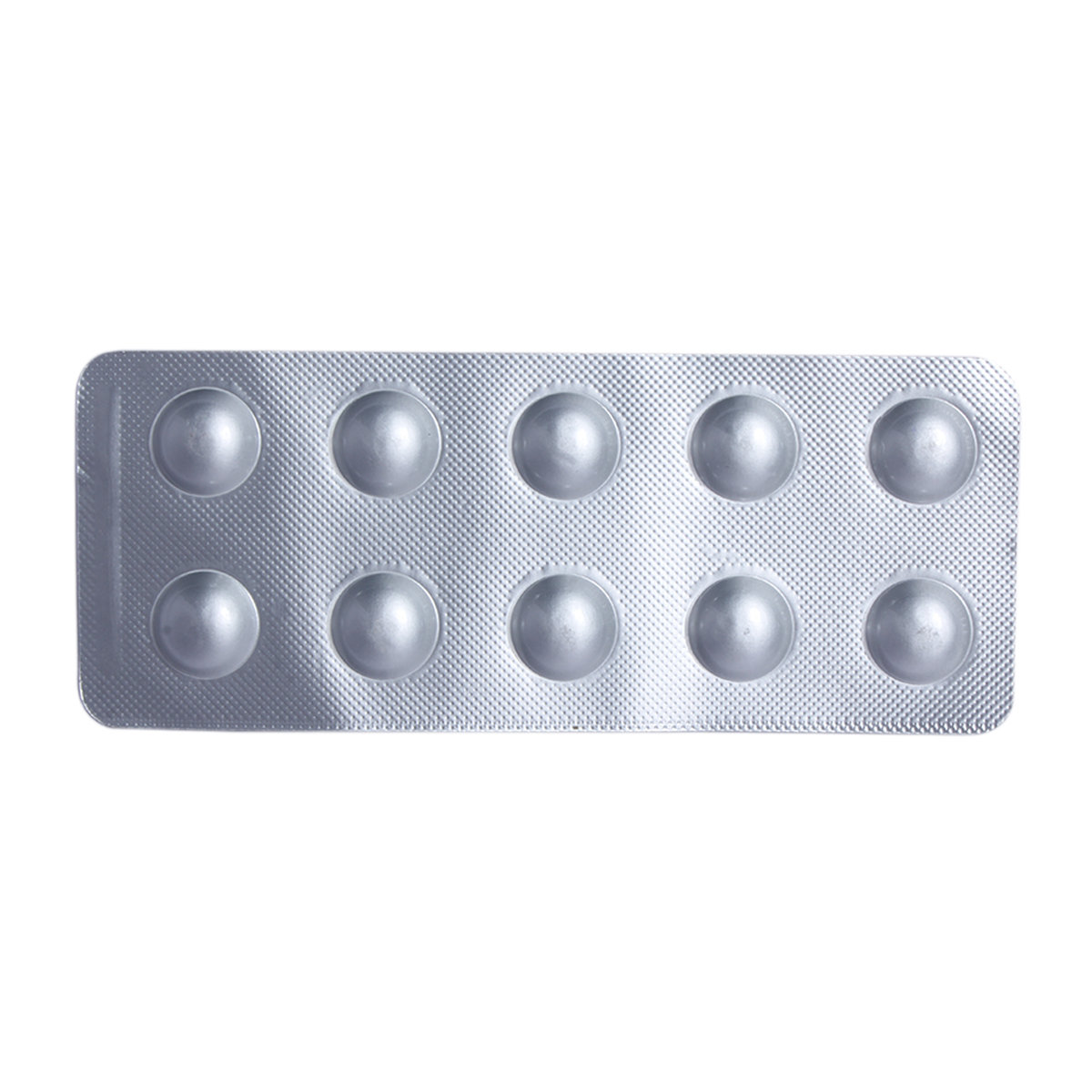


MRP ₹209
(Inclusive of all Taxes)
₹31.4 Cashback (15%)
Provide Delivery Location
Online payment accepted
 Prescription drug
Prescription drugWhats That
Composition :
Manufacturer/Marketer :
Consume Type :
Expires on or after :
Return Policy :
About Prasusafe 10mg Tablet
Prasusafe 10mg Tablet belongs to the group of medicines called 'antiplatelet agents' used to prevent the formation of blood clots, thereby reducing the chance of having a heart attack, or stroke in future. Prasusafe 10mg Tablet is prescribed after a heart attack, unstable angina, or if you have been treated with a procedure to open blocked arteries or have stents to open blocked/narrowed arteries.
Prasusafe 10mg Tablet contains 'Prasugrel' which works by inhibiting the clumping of platelets, thereby reducing the chance of having blood clot formation. This results in lower cardiovascular events like myocardial infarction (heart attack) or stroke in future, especially in people who have had heart surgery known as angioplasty.
You are advised to take Prasusafe 10mg Tablet for as long as your doctor has prescribed it for you depending upon your medical consition. In some cases, Prasusafe 10mg Tablet may cause side-effects such as nose bleeds, skin rash, bleeding in the bowels, blood in urine, low haemoglobin, purpura (blood leakage under the skin), indigestion and bruising. You are advised to talk to your doctor if you experience these side-effects persistently.
Do not take Prasusafe 10mg Tablet if you ever had a brain stroke, bleeding in the brain or transient ischemic attack (stroke). Talk to your doctor before taking Prasusafe 10mg Tablet if you weigh below 60 kg, are 75 years or older, have/had a recent severe injury or surgery due to risk of severe bleeding problems. Consult your doctor if you are pregnant or breastfeeding. Prasusafe 10mg Tablet is not recommended for children as efficacy and safety have not been established.
Uses of Prasusafe 10mg Tablet
Directions for Use
Key Benefits
Prasusafe 10mg Tablet belongs to the group of medicines called antiplatelet agents used to prevent the formation of blood clots. Prasusafe 10mg Tablet helps in reducing the chance of having another heart attack or stroke. Prasusafe 10mg Tablet inhibits platelet aggregation and activation through irreversible binding of its active metabolite to the receptors. Prasusafe 10mg Tablet works by inhibiting the clumping of platelets, thereby reduces the chance of blood clot formation. This helps in reducing the rate of cardiovascular events such as myocardial infarction (heart attack) or stroke especially in people who have had heart surgery known as angioplasty.
Storage
- Hydrate your body: Drink enough water to prevent dehydration and headaches.
- Calm Your Mind: Deep breathing and meditation can help you relax and relieve stress.
- Rest and Recharge: Sleep for 7-8 hours to reduce headache triggers.
- Take rest: lie down in a quiet, dark environment.
- Cold or warm compresses can help reduce tension.
- Stay Upright: Maintain good posture to keep symptoms from getting worse.
- To treat headaches naturally, try acupuncture or massage therapy.
- Over-the-counter pain relievers include acetaminophen and ibuprofen.
- Prescription Assistance: Speak with your doctor about more substantial drug alternatives.
- Severe Headaches: Seek emergency medical assistance for sudden, severe headaches.
- Frequent Headaches: If you get reoccurring headaches, consult your doctor.
- Headaches with Symptoms: Seek medical attention if your headaches include fever, disorientation, or weakness.
- Talk to your doctor about your back pain and potential medication substitutes or dose changes.
- Try yoga or Pilates and other mild stretching exercises to increase flexibility and strengthen your back muscles.
- To lessen the tension on your back, sit and stand upright and maintain proper posture.
- To alleviate discomfort and minimize inflammation, apply heat or cold packs to the afflicted area.
- Under your doctor's supervision, think about taking over-the-counter painkillers like acetaminophen or ibuprofen.
- Make ergonomic adjustments to your workspace and daily activities to reduce strain on your back.
- To handle tension that could make back pain worse, try stress-reduction methods like deep breathing or meditation.
- Use pillows and a supportive mattress to keep your spine in the right posture as you sleep.
- Back discomfort can worsen by bending, twisting, and heavy lifting.
- Speak with a physical therapist to create a customized training regimen to increase back strength and flexibility.
- Eat more plant based foods like vegetables, fruits and whole grains.
- Reduce intake of foods containing high fat such as dairy, oil and red meat.
- Exercise for at least 30 minutes 5 days a week.
- Aim for weight loss and maintain healthy weight.
- Quit smoking.
- Control blood sugar and blood pressure.
- Tell your doctor immediately if you experience shortness of breath after taking medication.
- Your doctor may adjust the medication regimen or dosage or give alternative medical procedures to minimize the symptoms of shortness of breath.
- Monitor your oxygen levels and breathing rate regularly to track changes and potential side effects.
- For controlling stress and anxiety, try relaxation techniques like deep breathing exercises, meditation, or yoga.
- Make lifestyle changes, such as quitting smoking, exercising regularly, and maintaining a healthy weight.
- Seek emergency medical attention if you experience severe shortness of breath, chest pain, or difficulty speaking.
- Follow up regularly with your doctor to monitor progress, adjust treatment plans, and address any concerns or questions.
- Inform your doctor about dizziness symptoms. They may adjust your medication regimen or prescribe additional medications to manage symptoms.
- Follow your doctor's instructions for taking medication, and take it at the same time every day to minimize dizziness.
- When standing up, do so slowly and carefully to avoid sudden dizziness.
- Avoid making sudden movements, such as turning or bending quickly, which can exacerbate dizziness.
- Drink plenty of water throughout the day to stay hydrated and help alleviate dizziness symptoms.
- If you're feeling dizzy, sit or lie down and rest until the dizziness passes.
- Track when dizziness occurs and any factors that may trigger it, and share this information with your doctor to help manage symptoms.
- Tell your doctor about the cough symptoms you're experiencing, which may be triggered by your medication.
- Your doctor may adjust your treatment plan by changing your medication, adding new medications, or providing guidance on managing your cough symptoms.
- Practice good hygiene, including frequent handwashing, avoiding close contact with others, and avoiding sharing utensils or personal items.
- Stay hydrated by drinking plenty of fluids, such as water, tea, or soup, to help thin out mucus and soothe your throat.
- Get plenty of rest and engage in stress-reducing activities to help your body recover. If your cough persists or worsens, consult your doctor for further guidance.
- Rest well; get enough sleep.
- Eat a balanced diet and drink enough water.
- Manage stress with yoga and meditation.
- Limit alcohol and caffeine.
- Physical activities like walking or jogging might help boost energy and make you feel less tired.
Drug Warnings
Do not take Prasusafe 10mg Tablet if you are allergic to any of its contents, if you have a medical condition that causes bleeding from the stomach or intestine, had a transient ischemic attack (stroke) or if you are suffering from severe liver disease. Talk to your doctor before taking Prasusafe 10mg Tablet if you have bleeding problems, weigh below 60 kg, are 75 years or older, had/have a recent serious injury or surgery, kidney or liver disease. Consult your doctor immediately if you develop a medical condition called thrombotic thrombocytopenic purpura (blood disorder) while taking Prasusafe 10mg Tablet ; its symptoms include fever, bruising under the skin which appears as red pinpoint dots, with/without unexplained confusion, tiredness and yellowing of skin and eyes. Consult your doctor if you are pregnant or breastfeeding. Prasusafe 10mg Tablet is not recommended for children as the efficacy and safety have not been established. People affected with active pathological bleeding (peptic ulcer, intracranial or brain haemorrhage) and history of stroke or transient ischemic attack (TIA) should not take Prasusafe 10mg Tablet .
Drug-Drug Interactions
Drug-Drug Interactions
Login/Sign Up
Co-administration of Mifepristone with Prasusafe 10mg Tablet can increase the chance of experiencing vaginal bleeding in women.
How to manage the interaction:
Taking Prasusafe 10mg Tablet with Mifepristone can lead to an interaction, but it can be taken if a doctor has prescribed it. However, if you experience prolonged, heavy bleeding, consult a doctor immediately. Do not discontinue the medication without consulting a doctor.
Co-administration of Abciximab with Prasusafe 10mg Tablet can increase the risk of bleeding.
How to manage the interaction:
Taking Prasusafe 10mg Tablet with Abciximab together can possibly result in an interaction, but it can be taken if a doctor has advised it. However, if you have any of the following symptoms: unusual bleeding or bruising, vomiting, blood in your urine or stools, headache, dizziness, or weakness, consult the doctor. Do not stop using any medications without talking to a doctor.
Co-administration of Prasusafe 10mg Tablet with Ibritumomab tiuxetan (90y) can increase the risk of bleeding leading to serious blood loss.
How to manage the interaction:
Co-administration of Prasusafe 10mg Tablet with Ibritumomab tiuxetan (90y) can possibly result in an interaction, but it can be taken if a doctor has advised it. However, if you experience unusual bleeding or bruising, dizziness, lightheadedness, red or black, tarry stools, coughing up or vomiting fresh or dried blood that looks like coffee grounds, severe headache, and weakness, consult the doctor. Do not stop using any medications without a doctor's advice.
Taking Prasusafe 10mg Tablet with ruxolitinib can increase the risk of bleeding.
How to manage the interaction:
Co-administration of Prasusafe 10mg Tablet with Ruxolitinib can possibly result in an interaction, but it can be taken if a doctor has advised it. However, consult the doctor immediately if you experience symptoms such as any unusual bleeding or bruising, dizziness, lightheadedness, red or black tarry stools, coughing up or vomiting fresh or dried blood that looks like coffee grounds, severe headache, and weakness. Do not stop using any medications without a doctor's advice.
Co-administration of Prasusafe 10mg Tablet with Ponatinib can increase the risk of bleeding.
How to manage the interaction:
Taking Ponatinib with Prasusafe 10mg Tablet together can possibly result in an interaction, but it can be taken if a doctor has advised it. However, if you experience unusual bleeding or bruising, dizziness, lightheadedness, red or black, tarry stools, coughing up or vomiting fresh or dried blood that looks like coffee grounds, severe headache, and weakness, consult the doctor. Do not stop using any medications without a doctor's advice.
Co-administration of Prasusafe 10mg Tablet and Rivaroxaban can increase the risk of bleeding problems.
How to manage the interaction:
Co-administration of Prasusafe 10mg Tablet and Rivaroxaban can lead to an interaction, it can be taken if advised by a doctor. However, if you experience any symptoms like unusual bleeding or bruising, dizziness, lightheadedness, red or black, tarry stools, coughing up or vomiting fresh or dried blood that looks like coffee grounds, severe headache, and weakness, consult the doctor immediately. Do not stop using any medications without a doctor's advice.
Co-administration of Flurbiprofen with Prasusafe 10mg Tablet can increase the risk of bleeding.
How to manage the interaction:
Taking Flurbiprofen with Prasusafe 10mg Tablet together can possibly result in an interaction, but it can be taken if a doctor has advised it. However, if you experience dizziness; lightheadedness, red or black, tarry stools, coughing up or vomiting fresh or dried blood that looks like coffee grounds, severe headache; and weakness contact a doctor immediately. Do not discontinue any medications without consulting a doctor.
Co-administration of Warfarin with Prasusafe 10mg Tablet can increase the risk of bleeding.
How to manage the interaction:
Although taking Prasusafe 10mg Tablet and warfarin together can result in an interaction, it can be taken if a doctor has prescribed it. However, if you have unusual bleeding or bruising, dizziness, lightheadedness, red or black, tarry stools, coughing up or vomiting fresh or dried blood that looks like coffee grounds, severe headache, and weakness, consult a doctor. Do not stop using any medications without a doctor's advice.
Co-administration of Prasusafe 10mg Tablet with Enoxaparin can increase the risk or severity of bleeding.
How to manage the interaction:
Although there is a possible interaction between Prasusafe 10mg Tablet and Enoxaparin, you can take them if advised by a doctor. However, if you notice any unusual bleeding or bruising, other signs of bleeding, dizziness, lightheadedness, red or black tarry stools, coughing up or vomiting blood, severe headache, and weakness, you should contact a doctor immediately. Do not stop using any medications without talking to a doctor. Do not stop using any medications without a doctor's advice.
Co-administration of Prasusafe 10mg Tablet with Anistreplase can increase the risk of bleeding and hemorrhage.
How to manage the interaction:
Co-administration of Prasusafe 10mg Tablet with Anistreplase can possibly result in an interaction, but it can be taken if a doctor has advised it. However, if you experience unusual bleeding or bruising, dizziness, lightheadedness, red or black, tarry stools, coughing up or vomiting fresh or dried blood that looks like coffee grounds, severe headache, and weakness, consult the doctor. Do not stop using any medications without a doctor's advice.
Drug-Food Interactions
Drug-Food Interactions
Login/Sign Up
St. John’S Wort, Garlic Pill, Aloevera, Cannabis
How to manage the interaction:
Taking herbs during treatment with Prasusafe 10mg Tablet may lead to an interaction. Avoid herbs like garlic, ginger, bilberry, danshen, piracetam, and ginkgo biloba during treatment with Prasusafe 10mg Tablet.
Diet & Lifestyle Advise
- Eat a diet rich in whole grains, vegetables, fruits, skinless poultry, fish, eggs, and low-fat dairy products.
- Avoid smoking and alcohol consumption.
- Maintain a healthy weight with proper diet and exercise.
- Managing stress with meditation, yoga, and massage.
- Avoid eating fried food, fast food, boxed food, canned food, and processed frozen meals.
Side Effects of Prasusafe 10mg Tablet
- Nose bleeds
- Skin rash
- Bleeding in bowels
- Blood in urine
- Low haemoglobin
- Purpura (blood leakage under the skin)
- Indigestion
- Bruising
Habit Forming
Therapeutic Class
All Substitutes & Brand Comparisons
RX
Out of StockPrax Tablet 10's
Torrent Pharmaceuticals Ltd
₹15
(₹1.35 per unit)
92% CHEAPERRX
Out of StockApagrel 10 mg Tablet 6's
Intas Pharmaceuticals Ltd
₹90
(₹13.5 per unit)
28% CHEAPERRX
Out of StockPrethromb-10Mg Tablet
Exeltis Healthcare Global
₹150
(₹13.5 per unit)
28% CHEAPER
Product Substitutes
Author Details
We provide you with authentic, trustworthy and relevant information
Drug-Diseases Interactions
Drug-Diseases Interactions
Login/Sign Up
FAQs
Prasusafe 10mg Tablet works by inhibiting the clumping of platelets, thereby reduces the chance of blood clot formation. This helps in reducing the rate of cardiovascular events such as myocardial infarction (heart attack) or stroke.
Prasusafe 10mg Tablet prevents the formation of blood clots so it might increase the risk of bleeding during injury, cut or surgery. Therefore, be cautious while using sharp objects. Consult a doctor immediately if you notice excess bleeding. Let your doctor know if you are going to have any scheduled surgery as your doctor might reduce the dose to avoid excess bleeding during surgery.
Please do not stop taking Prasusafe 10mg Tablet on your own, as it might increase the risk of a heart attack. Continue taking Prasusafe 10mg Tablet for as long as your doctor has prescribed it to you. Do not be reluctant to speak with your doctor if you experience any difficulty while taking Prasusafe 10mg Tablet .
Prasusafe 10mg Tablet may cause anaemia (low haemoglobin and low red blood cell count). So it would be best if you include iron-rich food in your diet to prevent anaemia.
Avoid taking non-steroidal anti-inflammatory drugs (pain-relieving medicines) like aspirin along with Prasusafe 10mg Tablet as it may increase the risk of gastrointestinal ulcer and bleeding.
Drug-Drug Interactions Checker List
- ASPIRIN
- IBUPROFEN
- CELECOXIB
- HYDROCODONE
- TRAMADOL
- CLOPIDOGREL
- ENOXAPARIN
- RIVAROXABAN
- WARFARIN
- ESOMEPRAZOLE
- OMEPRAZOLE
- TICAGRELOR
Special Advise
Regular haemoglobin and hematocrit diagnostic tests are recommended if you are taking Prasusafe 10mg Tablet .
Disease/Condition Glossary
Blood clot: Platelets are small cell particles that circulate in the blood. When the blood vessel is damaged or cut, the platelets clump together and lead to the formation of a clot, thereby prevents bleeding. The formation of clots in arteries can cut off the blood supply, leading to heart attack, stroke or death. Clot formation in the arteries that supply blood to the heart may cause reduced blood flow which could lead to unstable angina (chest pain).
Myocardial infarction: Myocardial infarction, also known as a heart attack or stroke could occur due to the lack of blood and oxygen supply in the heart. Symptoms include chest pain, upper body pain, sweating, weakness, trouble breathing, lightheadedness and nausea.

Have a query?
Buy best Cardiology products by
Torrent Pharmaceuticals Ltd
Sun Pharmaceutical Industries Ltd
Lupin Ltd
Intas Pharmaceuticals Ltd
Cipla Ltd
Micro Labs Ltd
Macleods Pharmaceuticals Ltd
Abbott India Ltd
Ajanta Pharma Ltd
Ipca Laboratories Ltd
Eris Life Sciences Ltd
Mankind Pharma Pvt Ltd
Lloyd Healthcare Pvt Ltd
Dr Reddy's Laboratories Ltd
Glenmark Pharmaceuticals Ltd
Emcure Pharmaceuticals Ltd
Alembic Pharmaceuticals Ltd
Alkem Laboratories Ltd
East West Pharma India Pvt Ltd
USV Pvt Ltd
Zydus Healthcare Ltd
Aristo Pharmaceuticals Pvt Ltd
Elbrit Life Sciences Pvt Ltd
J B Chemicals & Pharmaceuticals Ltd
Zydus Cadila
Akumentis Healthcare Ltd
Alteus Biogenics Pvt Ltd
Hbc Life Sciences Pvt Ltd
Fusion Health Care Pvt Ltd
Troikaa Pharmaceuticals Ltd
La Renon Healthcare Pvt Ltd
Corona Remedies Pvt Ltd
Jubilant Lifesciences Ltd
Medley Pharmaceuticals Ltd
Knoll Healthcare Pvt Ltd
Msn Laboratories Pvt Ltd
Zuventus Healthcare Ltd
Cadila Pharmaceuticals Ltd
Blue Cross Laboratories Pvt Ltd
Lividus Pharmaceuticals Pvt Ltd
Morepen Laboratories Ltd
Ranmarc Labs
Shrrishti Health Care Products Pvt Ltd
Sanofi India Ltd
Steris Healthcare
Elder Pharmaceuticals Ltd
Primus Remedies Pvt Ltd
Unison Pharmaceuticals Pvt Ltd
Eswar Therapeutics Pvt Ltd
Knoll Pharmaceuticals Ltd
Tas Med India Pvt Ltd
Systopic Laboratories Pvt Ltd
Indiabulls Pharmaceuticals Pvt Ltd
Leeford Healthcare Ltd
Sinsan Pharmaceuticals Pvt Ltd
Biochem Pharmaceutical Industries Ltd
Cadila Healthcare Ltd
Azkka Pharmaceuticals Pvt Ltd
Nirvana India Pvt Ltd
Orsim Pharma
Prevego Healthcare & Research Pvt Ltd
Econ Healthcare
Elinor Pharmaceuticals (P) Ltd
FDC Ltd
Sunij Pharma Pvt Ltd
Nicholas Piramal India Ltd
Astra Zeneca Pharma India Ltd
Pfizer Ltd
Lia Life Sciences Pvt Ltd
Shine Pharmaceuticals Ltd
Elicad Pharmaceuticals Pvt Ltd
Indoco Remedies Ltd
Proqol Health Care Pvt Ltd
Vasu Organics Pvt Ltd
Biocon Ltd
Opsis Care Lifesciences Pvt Ltd
Johnlee Pharmaceuticals Pvt Ltd
Merck Ltd
Wockhardt Ltd
Auspharma Pvt Ltd
Ergos Life Sciences Pvt Ltd
Lakshya Life Sciences Pvt Ltd
Ordain Health Care Global Pvt Ltd
Pficus De Med Pvt Ltd
ALICAN PHARMACEUTICAL PVT LTD
RPG Life Sciences Ltd
Glynis Pharmaceuticals Pvt Ltd
Orris Pharmaceuticals
Samarth Life Sciences Pvt Ltd
Aprica Pharmaceuticals Pvt Ltd
Aretaeus Pharmaceuticals Pvt Ltd
Koye Pharmaceuticals Pvt Ltd
Neocardiab Care
Retra Life Science Pvt Ltd
Alniche Life Sciences Pvt Ltd
Alvio Pharmaceuticals Pvt Ltd
Arkas Pharma Pvt Ltd
Atos Lifesciences Pvt Ltd
Divine Savior Pvt Ltd
Metalis Lifesciences Pvt Ltd
Alcohol
Safe if prescribed
You are recommended to avoid alcohol consumption while taking Prasusafe 10mg Tablet to prevent unpleasant side-effects. Alcohol intake might increase the risk of stomach or intestine bleeding.
Pregnancy
Consult your doctor
Please consult your doctor if you have any concerns regarding this, your doctor will prescribe only if the benefits outweigh the risks.
Breast Feeding
Consult your doctor
Please consult your doctor if you have any concerns regarding this; your doctor will prescribe only if the benefits outweigh the risks.
Driving
Safe if prescribed
Prasusafe 10mg Tablet does not affect your ability to drive. However, do not drive or operate heavy machinery if you are not alert.
Liver
Consult your doctor
Dose adjustment may be needed. Prasusafe 10mg Tablet should be used with caution in patients with liver impairment/liver disease. Please consult your doctor if you have liver impairment/liver disease or any concerns regarding this.
Kidney
Consult your doctor
Dose adjustment may be needed. Prasusafe 10mg Tablet should be used with caution in patients with kidney impairment/kidney disease. Please consult your doctor if you have kidney impairment/kidney disease or any concerns regarding this.
Children
Safe if prescribed
Prasusafe 10mg Tablet should not be used by children, as the efficacy and safety have not been established.
Recommended for a 30-day course: 3 Strips





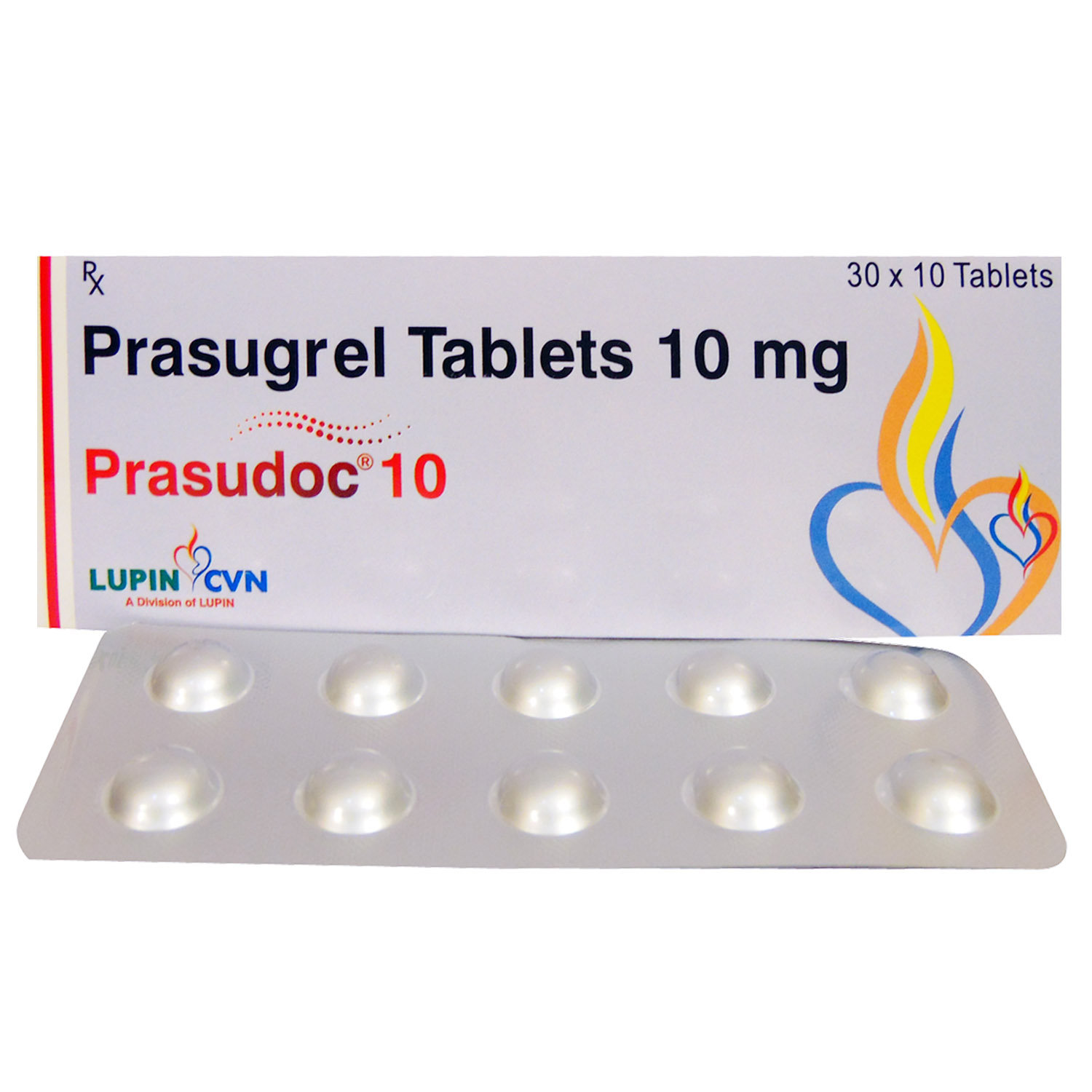

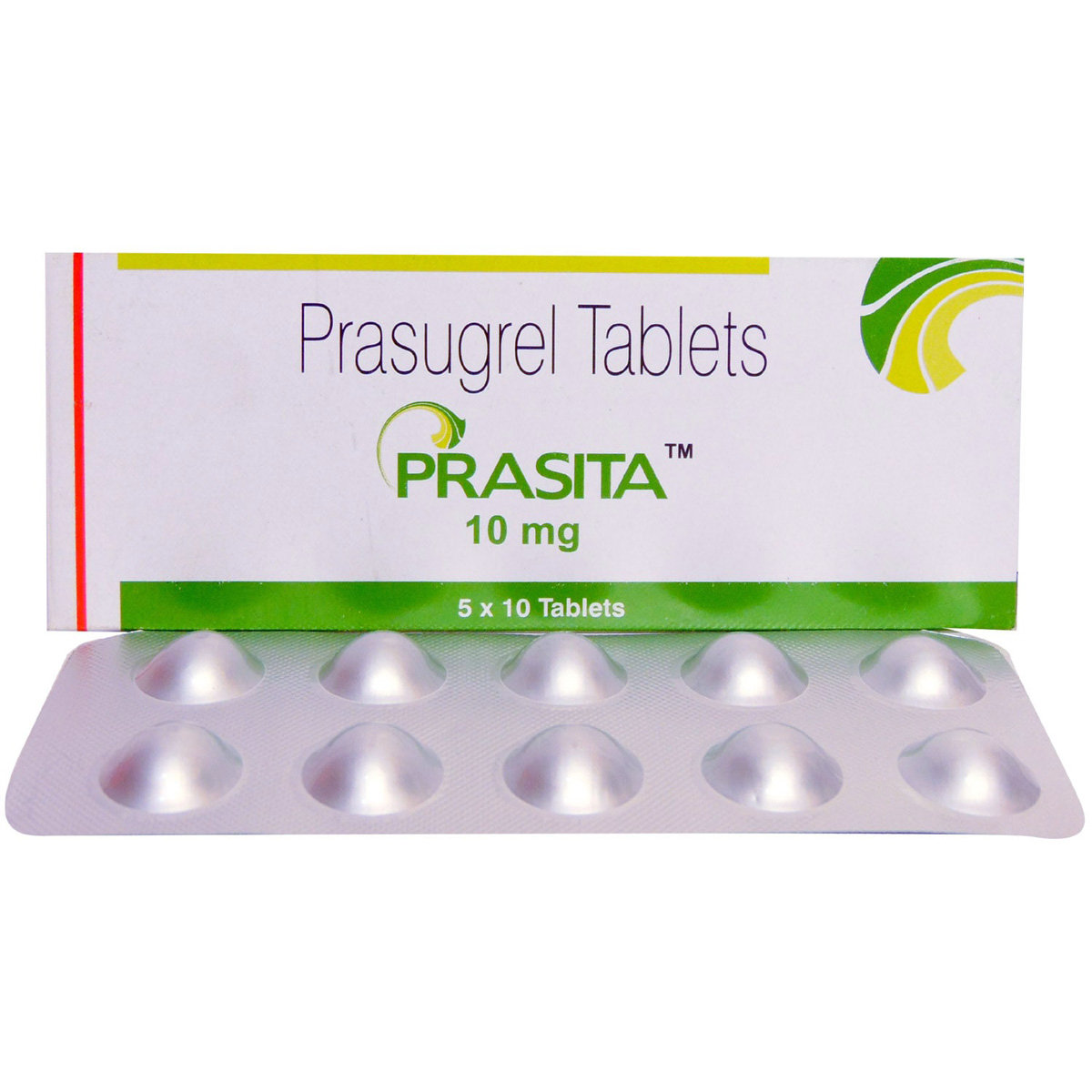

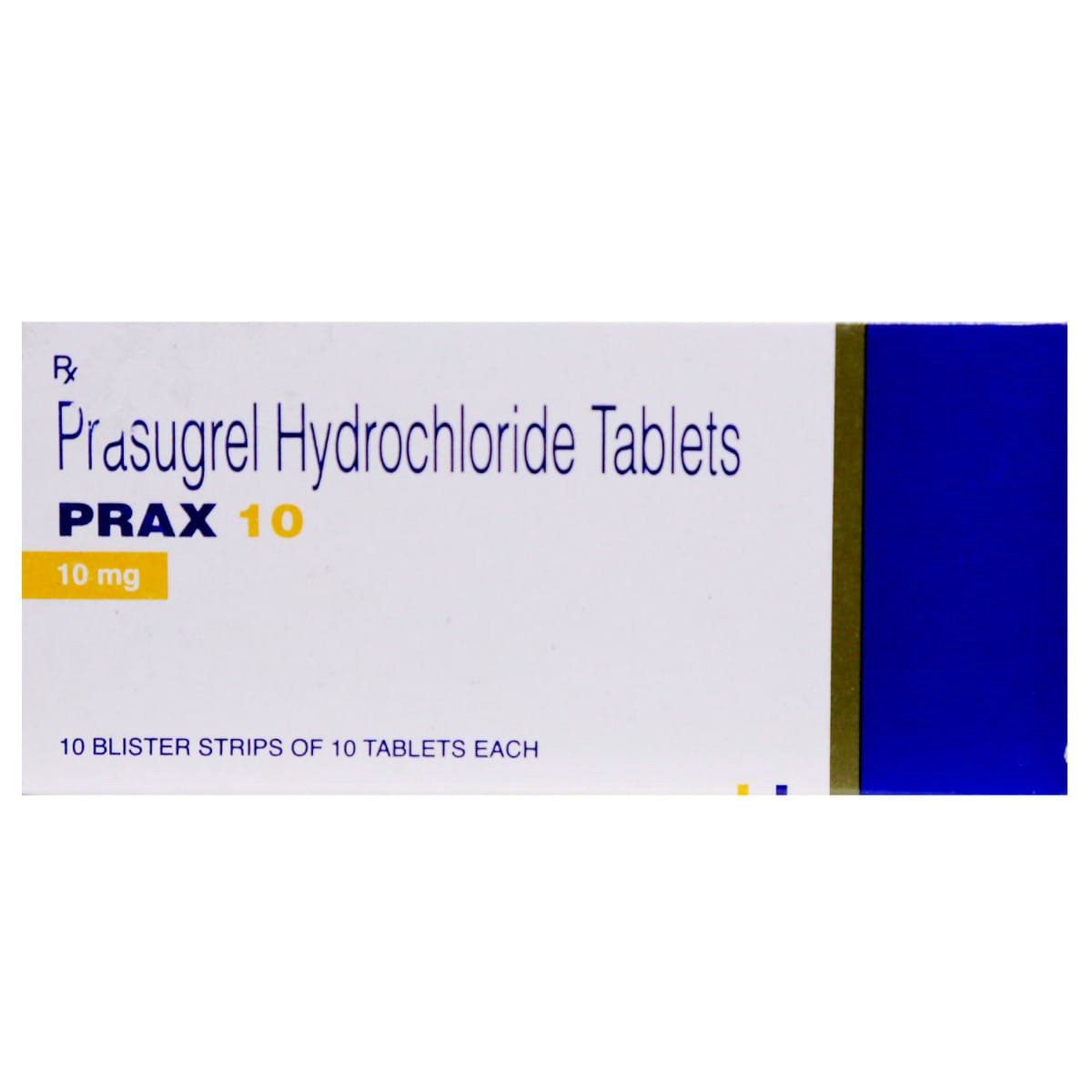

_0.jpg?tr=q-85)

